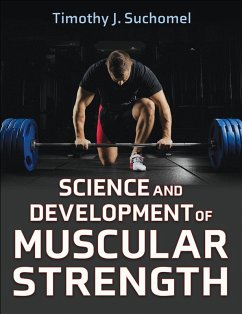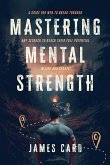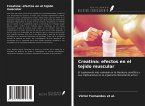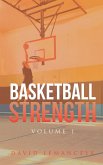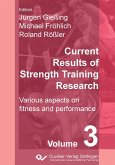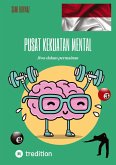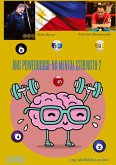Timothy J. Suchomel
Science and Development of Muscular Strength
Timothy J. Suchomel
Science and Development of Muscular Strength
- Gebundenes Buch
- Merkliste
- Auf die Merkliste
- Bewerten Bewerten
- Teilen
- Produkt teilen
- Produkterinnerung
- Produkterinnerung
The latest science, application, and research, including over 2,500 references, Science and Development of Muscular Strength is the definitive resource for anyone looking to understand, build, and optimize muscular strength for peak performance.
Andere Kunden interessierten sich auch für
![Health by Muscular Gymnastics Health by Muscular Gymnastics]() William J CromieHealth by Muscular Gymnastics33,99 €
William J CromieHealth by Muscular Gymnastics33,99 €![Mastering Mental Strength Mastering Mental Strength]() James CardMastering Mental Strength27,99 €
James CardMastering Mental Strength27,99 €![Creatina: efectos en el tejido muscular Creatina: efectos en el tejido muscular]() Victor Fernandes et al.Creatina: efectos en el tejido muscular28,99 €
Victor Fernandes et al.Creatina: efectos en el tejido muscular28,99 €![Basketball Strength Basketball Strength]() David LemanczykBasketball Strength28,99 €
David LemanczykBasketball Strength28,99 €![Current Results of Strength Training Research. Various aspects on fitness and performance Current Results of Strength Training Research. Various aspects on fitness and performance]() Current Results of Strength Training Research. Various aspects on fitness and performance31,50 €
Current Results of Strength Training Research. Various aspects on fitness and performance31,50 €![Pusat kekuatan mental Pusat kekuatan mental]() Sami DuymazPusat kekuatan mental31,90 €
Sami DuymazPusat kekuatan mental31,90 €![Ang powerhouse ng mental strength 2 Ang powerhouse ng mental strength 2]() Sami DuymazAng powerhouse ng mental strength 239,90 €
Sami DuymazAng powerhouse ng mental strength 239,90 €-
-
-
The latest science, application, and research, including over 2,500 references, Science and Development of Muscular Strength is the definitive resource for anyone looking to understand, build, and optimize muscular strength for peak performance.
Hinweis: Dieser Artikel kann nur an eine deutsche Lieferadresse ausgeliefert werden.
Hinweis: Dieser Artikel kann nur an eine deutsche Lieferadresse ausgeliefert werden.
Produktdetails
- Produktdetails
- Verlag: Human Kinetics Publishers
- Seitenzahl: 304
- Erscheinungstermin: 3. Juli 2025
- Englisch
- Abmessung: 279mm x 216mm
- ISBN-13: 9781718223660
- ISBN-10: 1718223668
- Artikelnr.: 72801306
- Herstellerkennzeichnung
- Libri GmbH
- Europaallee 1
- 36244 Bad Hersfeld
- gpsr@libri.de
- Verlag: Human Kinetics Publishers
- Seitenzahl: 304
- Erscheinungstermin: 3. Juli 2025
- Englisch
- Abmessung: 279mm x 216mm
- ISBN-13: 9781718223660
- ISBN-10: 1718223668
- Artikelnr.: 72801306
- Herstellerkennzeichnung
- Libri GmbH
- Europaallee 1
- 36244 Bad Hersfeld
- gpsr@libri.de
Timothy J. Suchomel, PhD, CSCS,*D, RSCC,*D, mISCP, is an associate professor and the director of the sports science master’s program at the University of Pittsburgh. He has published over 110 peer-reviewed journal articles on topics such as strength and power development, weightlifting movements and their derivatives, eccentric training methods, postactivation potentiation, and athlete monitoring. Suchomel has served the National Strength and Conditioning Association (NSCA) as the chair of the Sport Science Special Interest Group, the Wisconsin state director, and a research committee member, and he currently serves as senior associate editor of the Journal of Strength and Conditioning Research and associate editor for Strength and Conditioning Journal. He was honored by the NSCA with the State/Provincial Director of the Year Award in 2019, the Terry J. Housh Outstanding Young Investigator Award in 2022, and the Journal of Strength and Conditioning Research Editorial Excellence Award in 2023. Suchomel is a certified strength and conditioning specialist with distinction (CSCS,*D) and a registered strength and conditioning coach with distinction (RSCC,*D) through the NSCA and has been recognized as a master international strength and conditioning practitioner (mISCP) through the International Universities Strength and Conditioning Association (IUSCA). Suchomel completed his bachelor’s degree in kinesiology at the University of Wisconsin–Oshkosh in 2010, master’s degree in human performance at the University of Wisconsin–La Crosse in 2012, and doctoral degree in sport physiology and performance at East Tennessee State University in 2015.
Chapter 1. Defining Strength
The History of Strength Competitions
Definitions of Strength
The Importance of Strength Within Sport
Redefining Strength
Strength Definition
Chapter 2. Strength-Related Responses and Adaptations to Training
Neuromuscular System
General Adaptation Syndrome
Fitness–Fatigue Paradigm
Timeline of Adaptation
Adaptations to Training
Influence of Training Stimuli on Strength Adaptations
Impact of the Training Year
Detraining
External Stressors
Chapter 3. Mechanisms of Strength
Genetics and Epigenetics (Nature and Nurture)
Fiber Type
Neuromuscular Factors
Neuroendocrine System
Muscle Architecture
Motor Learning and Skill Acquisition
Chapter 4. Principles and Organization of Training
Training Principles
Organization of Training
Chapter 5. Training Methods
Types of Training
Additional Training Methods
Chapter 6. Advanced Training Methods
Relative Strength Levels
Potentiation Complexes
Variable Resistance Training
Accentuated Eccentric Loading
Chapter 7. Program Design
Needs Analysis
Programming Variables
Training Age
Training Year
Overall Training Approach
Chapter 8. Concurrent Training
The Interference Effect
Conditioning Methods
Concurrent Training Programming Considerations
Practical Application
Chapter 9. Measuring Strength
Rationale for Measuring Strength
Strength Testing Considerations
Types of Strength Testing
Combined Assessment Methods
Timing of Testing
Integration of Sport Science and Evidence-Based Practice
Chapter 10. Monitoring and Adjusting Training Loads
Monitoring and Load Adjustment Methods
Motor Learning and Skill Acquisition Monitoring
Additional Considerations for Monitoring and Load Adjustment
Chapter 11. Nutritional Considerations for Muscular Strength
Energy Balance
Macronutrients
Micronutrients
Antioxidants
Hydration
Ergogenic Aids
Periodization of Nutrition
Monitoring Nutrition
Chapter 12. Recovery Consideration for Strength
Recovery Methods
Mental Fatigue and Recovery
The Placebo Effect
Periodization of Recovery
Measuring Recovery
The History of Strength Competitions
Definitions of Strength
The Importance of Strength Within Sport
Redefining Strength
Strength Definition
Chapter 2. Strength-Related Responses and Adaptations to Training
Neuromuscular System
General Adaptation Syndrome
Fitness–Fatigue Paradigm
Timeline of Adaptation
Adaptations to Training
Influence of Training Stimuli on Strength Adaptations
Impact of the Training Year
Detraining
External Stressors
Chapter 3. Mechanisms of Strength
Genetics and Epigenetics (Nature and Nurture)
Fiber Type
Neuromuscular Factors
Neuroendocrine System
Muscle Architecture
Motor Learning and Skill Acquisition
Chapter 4. Principles and Organization of Training
Training Principles
Organization of Training
Chapter 5. Training Methods
Types of Training
Additional Training Methods
Chapter 6. Advanced Training Methods
Relative Strength Levels
Potentiation Complexes
Variable Resistance Training
Accentuated Eccentric Loading
Chapter 7. Program Design
Needs Analysis
Programming Variables
Training Age
Training Year
Overall Training Approach
Chapter 8. Concurrent Training
The Interference Effect
Conditioning Methods
Concurrent Training Programming Considerations
Practical Application
Chapter 9. Measuring Strength
Rationale for Measuring Strength
Strength Testing Considerations
Types of Strength Testing
Combined Assessment Methods
Timing of Testing
Integration of Sport Science and Evidence-Based Practice
Chapter 10. Monitoring and Adjusting Training Loads
Monitoring and Load Adjustment Methods
Motor Learning and Skill Acquisition Monitoring
Additional Considerations for Monitoring and Load Adjustment
Chapter 11. Nutritional Considerations for Muscular Strength
Energy Balance
Macronutrients
Micronutrients
Antioxidants
Hydration
Ergogenic Aids
Periodization of Nutrition
Monitoring Nutrition
Chapter 12. Recovery Consideration for Strength
Recovery Methods
Mental Fatigue and Recovery
The Placebo Effect
Periodization of Recovery
Measuring Recovery
Chapter 1. Defining Strength
The History of Strength Competitions
Definitions of Strength
The Importance of Strength Within Sport
Redefining Strength
Strength Definition
Chapter 2. Strength-Related Responses and Adaptations to Training
Neuromuscular System
General Adaptation Syndrome
Fitness–Fatigue Paradigm
Timeline of Adaptation
Adaptations to Training
Influence of Training Stimuli on Strength Adaptations
Impact of the Training Year
Detraining
External Stressors
Chapter 3. Mechanisms of Strength
Genetics and Epigenetics (Nature and Nurture)
Fiber Type
Neuromuscular Factors
Neuroendocrine System
Muscle Architecture
Motor Learning and Skill Acquisition
Chapter 4. Principles and Organization of Training
Training Principles
Organization of Training
Chapter 5. Training Methods
Types of Training
Additional Training Methods
Chapter 6. Advanced Training Methods
Relative Strength Levels
Potentiation Complexes
Variable Resistance Training
Accentuated Eccentric Loading
Chapter 7. Program Design
Needs Analysis
Programming Variables
Training Age
Training Year
Overall Training Approach
Chapter 8. Concurrent Training
The Interference Effect
Conditioning Methods
Concurrent Training Programming Considerations
Practical Application
Chapter 9. Measuring Strength
Rationale for Measuring Strength
Strength Testing Considerations
Types of Strength Testing
Combined Assessment Methods
Timing of Testing
Integration of Sport Science and Evidence-Based Practice
Chapter 10. Monitoring and Adjusting Training Loads
Monitoring and Load Adjustment Methods
Motor Learning and Skill Acquisition Monitoring
Additional Considerations for Monitoring and Load Adjustment
Chapter 11. Nutritional Considerations for Muscular Strength
Energy Balance
Macronutrients
Micronutrients
Antioxidants
Hydration
Ergogenic Aids
Periodization of Nutrition
Monitoring Nutrition
Chapter 12. Recovery Consideration for Strength
Recovery Methods
Mental Fatigue and Recovery
The Placebo Effect
Periodization of Recovery
Measuring Recovery
The History of Strength Competitions
Definitions of Strength
The Importance of Strength Within Sport
Redefining Strength
Strength Definition
Chapter 2. Strength-Related Responses and Adaptations to Training
Neuromuscular System
General Adaptation Syndrome
Fitness–Fatigue Paradigm
Timeline of Adaptation
Adaptations to Training
Influence of Training Stimuli on Strength Adaptations
Impact of the Training Year
Detraining
External Stressors
Chapter 3. Mechanisms of Strength
Genetics and Epigenetics (Nature and Nurture)
Fiber Type
Neuromuscular Factors
Neuroendocrine System
Muscle Architecture
Motor Learning and Skill Acquisition
Chapter 4. Principles and Organization of Training
Training Principles
Organization of Training
Chapter 5. Training Methods
Types of Training
Additional Training Methods
Chapter 6. Advanced Training Methods
Relative Strength Levels
Potentiation Complexes
Variable Resistance Training
Accentuated Eccentric Loading
Chapter 7. Program Design
Needs Analysis
Programming Variables
Training Age
Training Year
Overall Training Approach
Chapter 8. Concurrent Training
The Interference Effect
Conditioning Methods
Concurrent Training Programming Considerations
Practical Application
Chapter 9. Measuring Strength
Rationale for Measuring Strength
Strength Testing Considerations
Types of Strength Testing
Combined Assessment Methods
Timing of Testing
Integration of Sport Science and Evidence-Based Practice
Chapter 10. Monitoring and Adjusting Training Loads
Monitoring and Load Adjustment Methods
Motor Learning and Skill Acquisition Monitoring
Additional Considerations for Monitoring and Load Adjustment
Chapter 11. Nutritional Considerations for Muscular Strength
Energy Balance
Macronutrients
Micronutrients
Antioxidants
Hydration
Ergogenic Aids
Periodization of Nutrition
Monitoring Nutrition
Chapter 12. Recovery Consideration for Strength
Recovery Methods
Mental Fatigue and Recovery
The Placebo Effect
Periodization of Recovery
Measuring Recovery

